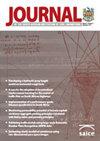南非设计降雨量估算中非平稳气候数据对极端降雨量影响的解释方法综述
IF 0.4
4区 工程技术
Q4 ENGINEERING, CIVIL
Journal of the South African Institution of Civil Engineering
Pub Date : 2021-11-11
DOI:10.17159/2309-8775/2021/v63n3a5
引用次数: 3
摘要
极端降雨和洪水事件的频率分析用于确定设计水坝、溢洪道和涵洞等水工结构所需的设计降雨量和设计洪水。极端事件频率分析的标准方法是基于平稳气候的假设。然而,随着越来越多的气候变化证据,降雨和洪水频率分析中的这一假设正受到挑战。据报道,由于气候变化,南非部分地区极端降雨事件的频率和规模有所增加,预计这些和其他极端降雨事件将持续到未来。气候的非平稳性可能导致降雨量的变化,这可能会影响极端降雨量估计和设计降雨量估计的准确性。这可能会对新水利基础设施的设计以及现有基础设施的修复产生重大影响。因此,需要开发考虑气候变化等非平稳数据的方法。这可以通过使用缩小规模的全球环流模型的数据来实现,以便识别影响降雨的非平稳气候变量,然后将其纳入非平稳数据序列的极值分析中。本文章由计算机程序翻译,如有差异,请以英文原文为准。
A review of methods to account for impacts of non-stationary climate data on extreme rainfalls for design rainfall estimation in South Africa
Frequency analysis of extreme rainfall and flood events are used to determine design rainfalls and design floods which are needed to design hydraulic structures such as dams, spillways and culverts. Standard methods for frequency analysis of extreme events are based on the assumption of a stationary climate. However, this assumption in rainfall and flood frequency analysis is being challenged with growing evidence of climate change. As a consequence of a changing climate, the frequency and magnitude of extreme rainfall events are reported to have increased in parts of South Africa, and these and other changes in extreme rainfall occurrences are expected to continue into the future. The possible non-stationarity in climate resulting in changes in rainfall may impact on the accuracy of the estimation of extreme rainfall quantities and design rainfall estimations. This may have significant consequences for the design of new hydraulic infrastructure, as well as for the rehabilitation of existing infrastructure. Hence, methods that account for non-stationary data, such as caused by climate change, need to be developed. This may be achieved by using data from downscaled global circulation models in order to identify non-stationary climate variables which affect rainfall, and which can then be incorporated into extreme value analysis of a non-stationary data series.
求助全文
通过发布文献求助,成功后即可免费获取论文全文。
去求助
来源期刊
CiteScore
0.70
自引率
25.00%
发文量
19
审稿时长
>12 weeks
期刊介绍:
The Journal of the South African Institution of Civil Engineering publishes peer reviewed papers on all aspects of Civil Engineering relevant to Africa. It is an open access, ISI accredited journal, providing authoritative information not only on current developments, but also – through its back issues – giving access to data on established practices and the construction of existing infrastructure. It is published quarterly and is controlled by a Journal Editorial Panel.
The forerunner of the South African Institution of Civil Engineering was established in 1903 as a learned society aiming to develop technology and to share knowledge for the development of the day. The minutes of the proceedings of the then Cape Society of Civil Engineers mainly contained technical papers presented at the Society''s meetings. Since then, and throughout its long history, during which time it has undergone several name changes, the organisation has continued to publish technical papers in its monthly publication (magazine), until 1993 when it created a separate journal for the publication of technical papers.

 求助内容:
求助内容: 应助结果提醒方式:
应助结果提醒方式:


